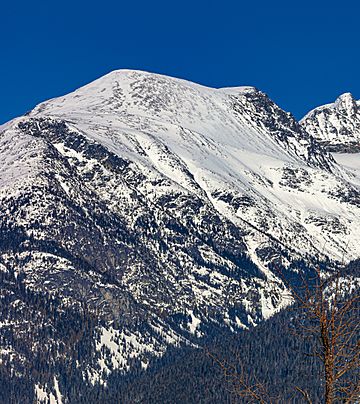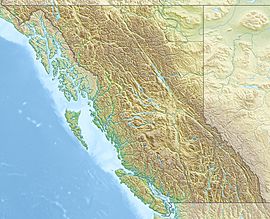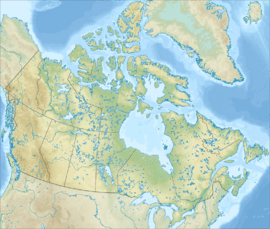Mount Cook (British Columbia) facts for kids
Quick facts for kids Mount Cook |
|
|---|---|

Mount Cook seen from Highway 99
|
|
| Highest point | |
| Elevation | 2,676 m (8,780 ft) |
| Prominence | 66 m (217 ft) |
| Parent peak | Mount Weart (2835 m) |
| Listing | Mountains of British Columbia |
| Geography | |
| Location | Garibaldi Provincial Park British Columbia, Canada |
| Parent range | Garibaldi Ranges Coast Ranges |
| Topo map | NTS 92J/02 |
| Climbing | |
| Easiest route | Scramble via west ridge |
Mount Cook is a tall mountain in British Columbia, Canada. It stands 2,676-metre (8,780-foot) high. You can find it in the Garibaldi Provincial Park, which is part of the Coast Mountains.
The mountain is located above the north side of Wedgemount Lake. It is about 13 km (8 mi) northeast of the town of Whistler. The closest higher mountain is Mount Weart, which is 1.2 km (1 mi) to the southeast.
Two glaciers are found near Mount Cook. The Armchair Glacier sits between Mount Cook and Mount Weart. The Weart Glacier is on the northern side of Mount Cook. Water from the melting glaciers and rain flows into Wedgemount Lake and the Green River.
Before it was named Mount Cook, the mountain was known as Miniweart or North Wedge. The name "Cook" was suggested in June 1977 by two mountain climbers, Neal Carter and Karl Ricker. They were members of the Alpine Club of Canada. The name was officially accepted on March 9, 1979, by the Geographical Names Board of Canada.
What is the Climate Like on Mount Cook?
Mount Cook is in a marine west coast climate zone. This means it has mild winters and cool summers. This type of climate is found in western North America.
Most of the weather systems that bring rain and snow start over the Pacific Ocean. They travel east towards the Coast Mountains. When these weather systems hit the mountains, they are forced to rise. This process is called orographic lift. As the air rises, it cools and drops its moisture as rain or snow.
Because of this, the Coast Mountains get a lot of rain and snow. This is especially true during the winter months. Temperatures on Mount Cook can drop very low, sometimes below −20 °C. With the wind, it can feel even colder, below −30 °C. The best time to climb Mount Cook is usually from July to September. This is when the weather is most favorable.
Can You Climb Mount Cook?
Yes, there are known ways to climb Mount Cook. These are called climbing routes.



